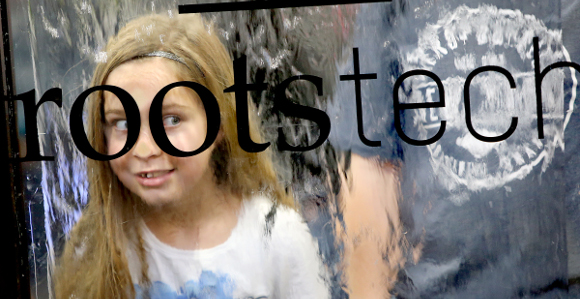5 Easy Ways to Involve Kids in Family History
Contributed By Marianne Holman Prescott, Church News staff writer

Zipporah Miles looks through a water feature at the RootsTech conference at the Salt Palace Convention Center in Salt Lake City on Saturday, February 6, 2016.
Article Highlights
- Even simple activities integrated with family stories can be a powerful teaching tool for all ages.
- Try recording family histories in simple formats.
- Record stories and feelings of relatives as soon as possible.
Related Links
Simple activities—when planned out properly—can turn a regular hobby into a lesson in family history.
Ginny Ackerson has been involved in family history work for more than four decades and serves on the Utah Genealogical Association Board. Following RootsTech conference’s theme, “Celebrating Families Across Generations,” Sister Ackerson spoke of easy ways parents can integrate stories from their family history in fun activities.
Whether it is writing in a journal, coloring pages, putting together a family storybook, or even playing a game, simple activities can be turned into teaching tools.
1. Journal writing
With a few supplies, parents can help their children create their own history from a very young age. Acid-free paper, pens, and a place to store the paper make it easy for people of all ages to compile a journal. For many, thinking of what to write is the hardest part.
Sister Ackerson encouraged parents to create prompts, questions, or topics to discuss for themselves and their children. Prompts don’t need to be long or extremely thought out. Many are available online for those who need help to start writing. While some prompts encourage children to describe their lives as they are, other prompts—such as “what if” questions—allow children to use their imagination.
Journal prompts can get deeper as children get a little older, asking them to explain or share experiences. A prompt could ask who their hero is and why, or ask a person to share a time when he or she struggled with a choice and made the right one. Prompts could also include goal setting and plans to achieve those goals.
A simple jar or container filled with prompts makes journal writing easy and accessible and, when left in a visible place, serves as a reminder of an available activity to do during free time.
2. Coloring page
For many children, coloring is a favorite activity done almost daily. Sharing a story from a family history that coincides with a coloring page is an easy way to help children learn about their ancestor while still having fun.
“Heritage coloring,” as Sister Ackerson called it, is a simple way to explain stories or characteristics of an ancestor to children. A coloring page showing a plane, a woman or man in military garb, or a map may capture important elements of a family story. Images representing family traditions—such as an object or a place—or an image that represents an event could be a great starting point in sharing a story. Images showing ethnic clothing that would have been worn by ancestors could be a tool to explain customs or traditions.
When children can visualize what they are hearing, they are able to make connections, hopefully helping them remember what they have heard, Sister Ackerson taught.
3. Puzzles and games
Online resources make it easy to create or customize word games—such as word searches, double puzzles, fallen phrases, letter tiles, cryptograms, hidden messages, or crossword puzzles—using family names, places, or customs.
A maze is a fun activity that, with a little creativity, could be used to tell a story of when someone was lost or an adventure an ancestor had experienced.
“The toys our grandparents played with are simple and easy to make,” Sister Ackerson said. Whirlygigs, cup and ball, button dolls, kites, paper dolls, flip books, paper airplanes, and panpipes are just a few examples of games ancestors could have played. If a family story includes a game—such as checkers, kick the can, red rover, or marbles—playing the game is a fun way to make the story come to life.
4. Family story books
“Decide on a simple format—persons, places, time periods, homes, family recipes, or a cookbook,” said Sister Ackerson.
Creating a book on a specific topic can be less intimidating than an entire family history and is easy to use in a family setting. Whether it is writing about family members who served in the military, creating a family cookbook, celebrating an anniversary or birthday, writing about pets, compiling important parts of each grade of school, or a way to remember trips or family vacations, each book can be a way to document important elements of a family history in a shorter, easier way to read.
A family dictionary is a fun way to explain expressions and words that family members use. Acting out family stories can also help children remember them.
5. Technology and communication
Although every tool might not be the right fit for every family, being creative in sharing stories is a way family histories are preserved and shared. For people who live in different areas than other family members, technology can be a powerful tool. Face-to-face storytelling via Skype or Facetime connects generations.
“Record heartfelt feelings and tales of an aging or ill relative before you lose the chance,” Sister Ackerson said.
Even simple activities, when integrating family stories, can be a powerful teaching tool for all ages.
